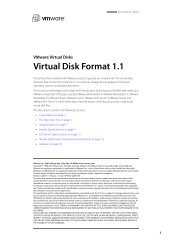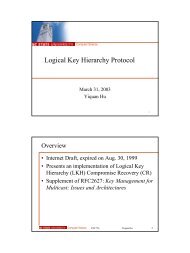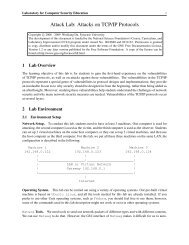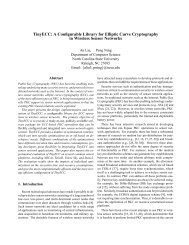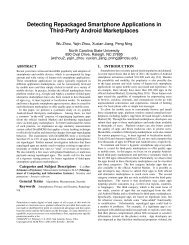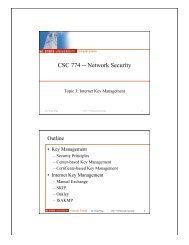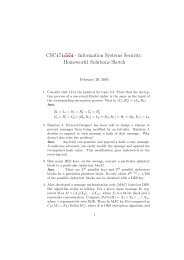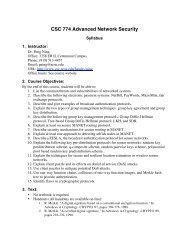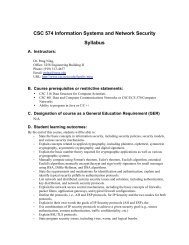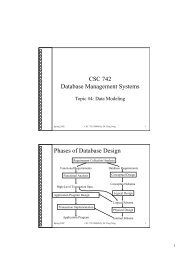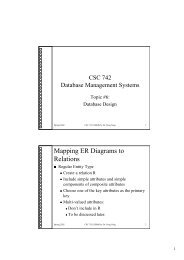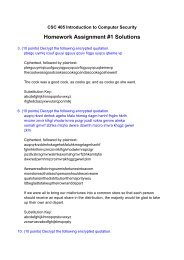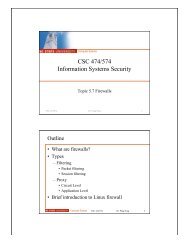Homework Assignment #2 Solutions
Homework Assignment #2 Solutions
Homework Assignment #2 Solutions
Create successful ePaper yourself
Turn your PDF publications into a flip-book with our unique Google optimized e-Paper software.
CSC 405 Introduction to Computer Security<br />
<strong>Homework</strong> <strong>Assignment</strong> <strong>#2</strong> <strong>Solutions</strong><br />
2. (20 points) Your boss hands you a microprocessor and its technical reference manual.<br />
You are asked to check for undocumented features of the processor. Because of the<br />
number of possibilities, you cannot test every operation code with every combination of<br />
operands. Outline the strategy you would use to identify and characterize unpublicized<br />
operations.<br />
Note: This is an open question; there is no strict answer for this question.<br />
Use the technical manual to make a list of the microprocessor's operation codes and<br />
what their expected range of operands should be. For each operation code, randomly<br />
choose a few operands to test, some within the expected range of operands, some at the<br />
extreme limits of the range and finally pick a few that are completely outside the range.<br />
3. (15 points) Your boss hands you a computer program and its technical reference manual.<br />
You are asked to check for undocumented features of the program. How is this activity<br />
similar to the task of the previous exercise? How dose it differ? Which is the more feasible?<br />
Why?<br />
Note: This is an open question; there is no strict answer for this question.<br />
We can use the same method in previous problem to test the computer program.<br />
For computer program, we know the source code or binary code. So we can use other<br />
methods, such as static analysis, to test it. In other words, we can use white box testing<br />
or gray box testing. But for the hardware, we can only use black box testing.<br />
Testing a computer program is more feasible, because we can use more methods.<br />
5. (20 points) A program is written to computer the sum of the integers from 1 to 10. The<br />
programmer, well trained in reusability and maintainability, writes the program so that it<br />
computes the sum of the numbers from k to n. However, a team of security specialists<br />
scrutinized the code. The team certified that the program properly set k to 1 and n to 10;<br />
therefore, the program is certified as being properly restricted in that it always operate on<br />
precisely the range 1 to 10. List different ways that this program can be sabotaged so that<br />
during execution it computes a different sum, for example, 3 to 20.<br />
a) Someone changes the source code before its complication,<br />
b) Someone patches (i.e.,) the binary object code while it is stored on disk before<br />
execution,<br />
c) During execution, an outside process patches the object code.
6. (15 points) One means of limiting the effect of an untrusted program is confinement:<br />
controlling what processes have access to the untrusted program and what access the<br />
program has to other processes and data. Explain how confinement would apply to the<br />
earlier example of the program that computes the sum of the integers 1 to 10.<br />
Assuming the only activity of the program is computing the sum from 1 to 10,<br />
confinement would achieve two things. First, the confining program would act as a<br />
filter between the callers and the untrusted program. A calling program would call the<br />
confining process, requesting to call the summation program. The calling program<br />
would have no direct access to the summation program. Second, the confining<br />
program would check the result to the summation program. In this simple situation,<br />
the confining process could check that the answer was exactly 55 (the sum from 1<br />
to10). In a more realistic situation, the confining process could check the computation<br />
for reasonableness: considering the magnitude of the input values, values of other<br />
system variables, the name or owner of the calling program, etc., is the result<br />
reasonable? Are the requests for access to auxiliary system resources by the<br />
untrusted program reasonable?<br />
Confining programs such as described here do exist. They are generally called<br />
“wrappers” because they wrap the untrusted code in a trustworthy filter<br />
7. (15 points) List three controls that could be applied to detect or prevent salami attacks.<br />
Examples of controls: (a) program development controls, in which the code of a<br />
program is rigorously scrutinized for improper activity, (b) spot checks of random<br />
accounts, involving recomputation of answers by hand to verify that correct amounts<br />
are being credited, and (c) requirement of matching totals for many intersecting<br />
subsets of accounts<br />
8. (15 points) The distinction between a covert storage channel and a covert timing channel<br />
is not clear-cut. Every timing channel can be transformed into an equivalent storage<br />
channel. Explain how this transformation could be done.<br />
Covert channels typically require access to a shared clock to time when bits become<br />
available in the covert resource and when bits can be replaced. Thus, even with pure<br />
storage channels, there is an element of timing.<br />
A covert timing channel works by modulating the time at which something occurs. But<br />
the something (which might be an interrupt or access to the CPU or unlocking a<br />
semaphore, for example) is itself a resource (the interrupt, the processing, or the<br />
semaphore), represented by a storage table entry. Thus, the table entry or the<br />
something itself becomes the shared resource visible to the two cooperating<br />
processes form which the covert channel is built.



